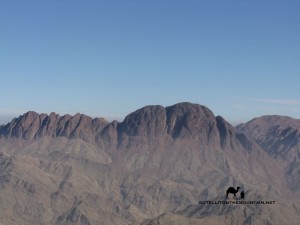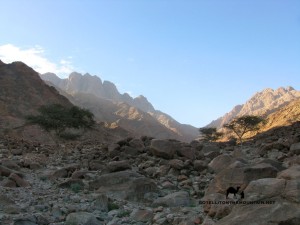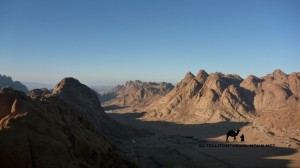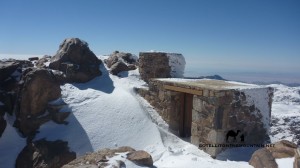 Every year, sometime in early January, Wadi Zelega is transformed from an ordinary desert wadi into a rugged race track for the annual Muzeina vs Tarabin Camel Race: the biggest event in the Bedouin sporting calendar. The Muzeina and Tarabin are two of the Sinai’s biggest tribes and this race goes back a long way. I don’t know exactly how long, or the full story behind it, but a Bedouin man told me it started when a boy of the Tarabin wanted to marry a girl of the Muzeina. Apparently, neither tribe wanted the marriage and it was thus agreed it’d proceed ONLY if the Tarabin boy won a camel race against the best riders of the Muzeina. Against all expectations, he did win. And ever since then, the race has been an annual fixture.
Every year, sometime in early January, Wadi Zelega is transformed from an ordinary desert wadi into a rugged race track for the annual Muzeina vs Tarabin Camel Race: the biggest event in the Bedouin sporting calendar. The Muzeina and Tarabin are two of the Sinai’s biggest tribes and this race goes back a long way. I don’t know exactly how long, or the full story behind it, but a Bedouin man told me it started when a boy of the Tarabin wanted to marry a girl of the Muzeina. Apparently, neither tribe wanted the marriage and it was thus agreed it’d proceed ONLY if the Tarabin boy won a camel race against the best riders of the Muzeina. Against all expectations, he did win. And ever since then, the race has been an annual fixture.
For local Bedouin, camels are a HUGE source of pride and derbies are fiercely contested. As a spectator, they’re the most authentic events you can see. There’s nothing staged about them. They’re REAL; by locals, for locals.
 This year – after missing it every other one – I HAD to see the race. I woke at dawn and got a jeep to Wadi Zelega with a few Bedouin friends from St Katherine: all long-time camel enthusiasts who’d make the perfect racing company. Bedouin camps were scattered all over the wadi when we arrived; traditional goat hair tents were rigged up near Toyota pick-up trucks and small groups of men huddled around fires making tea.
This year – after missing it every other one – I HAD to see the race. I woke at dawn and got a jeep to Wadi Zelega with a few Bedouin friends from St Katherine: all long-time camel enthusiasts who’d make the perfect racing company. Bedouin camps were scattered all over the wadi when we arrived; traditional goat hair tents were rigged up near Toyota pick-up trucks and small groups of men huddled around fires making tea.
I’d never seen so many Bedouin in one wadi. It’s how the old times might’ve looked, when tribes migrated together, in bigger groups.
Anyway, over where the camels stood, there was a big hullaballoo.
 A debate was raging about whether to hold the race or not. It had rained in the night and the sand was heavy and stodgy in places. Further along, pools stretched across the wadi. It all meant danger for the camels who – running at top speed – could easily stumble and break a leg or worse. More than that, it was dangerous for the jockeys; invariably small Bedouin boys, as young as seven or eight. Being thrown off the top of a sprinting camel could be nasty.
A debate was raging about whether to hold the race or not. It had rained in the night and the sand was heavy and stodgy in places. Further along, pools stretched across the wadi. It all meant danger for the camels who – running at top speed – could easily stumble and break a leg or worse. More than that, it was dangerous for the jockeys; invariably small Bedouin boys, as young as seven or eight. Being thrown off the top of a sprinting camel could be nasty.
Anyway, it was eventually decided the race WOULD be run.
And that – inshallah – everything would be OK.
 The camels were led to the start line as the jockeys were lifted up onto the saddles. They whispered last words to their camels as their fathers spoke to them and a long-winded Sheikh roared orders out over everybody through a megaphone. There was a bit of jostling on the start line before an AK47 was fired in the air. Then – with a sudden thudder of hooves – the camels were away, galloping off towards the horizon.
The camels were led to the start line as the jockeys were lifted up onto the saddles. They whispered last words to their camels as their fathers spoke to them and a long-winded Sheikh roared orders out over everybody through a megaphone. There was a bit of jostling on the start line before an AK47 was fired in the air. Then – with a sudden thudder of hooves – the camels were away, galloping off towards the horizon.
We legged it back to our jeep, pushing our way through the crowds and piling in the back as our driver simultaneously floored the pedal, throwing us all back in a heap against a half-open door. I staggered back up – feeling slightly dazed – and looked out of the window, only to see a Toyota pick up truck drive head first into a ditch. Another one missed a big retem bush with a last-minute swerve, sending three other jeeps into swerves too.
 We were in Wadi Zelega, but it felt like we were in Days of Thunder; dodging ruts and boulders whilst overtaking jeeps, then cutting them up; whatever worked best. Looking out at the camels I began to wonder where the real race was. There – or here. From what I could see of the camel race, it was clear stuff was already changing.
We were in Wadi Zelega, but it felt like we were in Days of Thunder; dodging ruts and boulders whilst overtaking jeeps, then cutting them up; whatever worked best. Looking out at the camels I began to wonder where the real race was. There – or here. From what I could see of the camel race, it was clear stuff was already changing.
A pack of leaders had pulled away. Some camels had slowed to a canter. Others had run into a no man’s land at the sides of the wadi. And some had stopped completely, with loose saddles, sores or other problems.
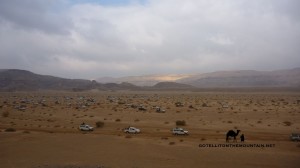 Just after the half way mark, our driver began a new manoeuvre, zig-zagging through lines of racing camels and jeeps from one side of Wadi Zelega to the other, then racing up a high promontory. Here, we got out and gazed out over the whole wadi. It looked beautiful: a wide desert wadi, with faraway skylines lit by the soft rays of the morning sun. Soon the wave of Bedouin jeeps surged through; the sound of beeping, shouting and the distant hum of engines all drifting up to us. From the ground, we could hardly see the camel race at all: here, we looked down from the sky, feeling like masters of it all.
Just after the half way mark, our driver began a new manoeuvre, zig-zagging through lines of racing camels and jeeps from one side of Wadi Zelega to the other, then racing up a high promontory. Here, we got out and gazed out over the whole wadi. It looked beautiful: a wide desert wadi, with faraway skylines lit by the soft rays of the morning sun. Soon the wave of Bedouin jeeps surged through; the sound of beeping, shouting and the distant hum of engines all drifting up to us. From the ground, we could hardly see the camel race at all: here, we looked down from the sky, feeling like masters of it all.
We let the wave pass, then tore back to surf on its danger again.
 The effects of the race were starting to show now. Some camels were foaming at the mouth; others had big, bleeding sores on their rumps from being whipped. They were going fast; not as fast as they had been. But still fast. At this stage it was all about endurance: this was the critical stage; the one where it’d all be won or lost. And, if ever there was a landscape for a moment of destiny – for a battle where every bit of power would be summoned for a last shot at glory – it was here, in the rugged wilds of Wadi Zelega.
The effects of the race were starting to show now. Some camels were foaming at the mouth; others had big, bleeding sores on their rumps from being whipped. They were going fast; not as fast as they had been. But still fast. At this stage it was all about endurance: this was the critical stage; the one where it’d all be won or lost. And, if ever there was a landscape for a moment of destiny – for a battle where every bit of power would be summoned for a last shot at glory – it was here, in the rugged wilds of Wadi Zelega.
On one side were the foreboding plateaulands of Jebel Gunna. On the other, Hadabat el Tih; a highland that stretches over the Sinai from one side to the other; the Bible’s epic Wilderness of the Wanderings.
The jockeys shouted at their camels, grinding out every bit of strength.
 They all surged forward but it was a Muzeina camel that took the critical advantage; holding a straighter line and edging ahead until his rivals couldn’t catch him and he had a clear run to the finish. This camel crossed about a minute before the rest, finishing a 20km track in about 45 minutes. The Muzeina celebrated, waving their shemaghs in the air and firing their battered old AK47s into the sky. I just crossed my fingers and hoped no bullets came down on my head. Over the next 15 minutes, the rest of the camels came in too: all of them caught and deservedly congratulated for finishing the Sinai’s toughest race.
They all surged forward but it was a Muzeina camel that took the critical advantage; holding a straighter line and edging ahead until his rivals couldn’t catch him and he had a clear run to the finish. This camel crossed about a minute before the rest, finishing a 20km track in about 45 minutes. The Muzeina celebrated, waving their shemaghs in the air and firing their battered old AK47s into the sky. I just crossed my fingers and hoped no bullets came down on my head. Over the next 15 minutes, the rest of the camels came in too: all of them caught and deservedly congratulated for finishing the Sinai’s toughest race.
I’m still not sure whether the Wadi Zelega Camel Race is a proper camel race or just the pretext upon which the Bedouin get together for a MASSIVE annual off road rally and dust up. It’s sometimes fast, almost always dangerous; but whatever it is, it’s AMAZING FUN and a highlight of any year. No other event pulls the Bedouin together like this today: this is the only one where you’ll see so many in their traditional tents; the only one where they meet so many old friends and just do something – with each other – that’s as BEDOUIN as anything will ever be. It doesn’t have the money or glitz of camel races in the Gulf states: but it feels more real. It’s run with real Sinai camels, trained and run by local Bedouin etc. I’ll definitely be going in 2015. But perhaps with a crash helmet…
 The Sinai has two Jebel Banats; one of them’s near St Katherine; the other, near Wadi Feiran. Jebel Banat means Mountain of the Girls and they’re both beautiful peaks with epic views. The Jebel Banat in Wadi Feiran has an added attraction though: a story. And if anything pulls me to a peak as much as the beauty, views and adventure, it’s a story. And this isn’t just any story; it’s one of the Sinai’s most famous. One the Bedouin were telling centuries ago. And one which is still being told today; I’ve heard everyone from Bedouin guides to taxi drivers and ibex hunters tell it. Like all good stories, it has a message. One they say helped improve the rights of local Bedouin women. One that’s maybe still relevant. It’s about two Bedouin sisters, from Wadi Feiran…
The Sinai has two Jebel Banats; one of them’s near St Katherine; the other, near Wadi Feiran. Jebel Banat means Mountain of the Girls and they’re both beautiful peaks with epic views. The Jebel Banat in Wadi Feiran has an added attraction though: a story. And if anything pulls me to a peak as much as the beauty, views and adventure, it’s a story. And this isn’t just any story; it’s one of the Sinai’s most famous. One the Bedouin were telling centuries ago. And one which is still being told today; I’ve heard everyone from Bedouin guides to taxi drivers and ibex hunters tell it. Like all good stories, it has a message. One they say helped improve the rights of local Bedouin women. One that’s maybe still relevant. It’s about two Bedouin sisters, from Wadi Feiran…